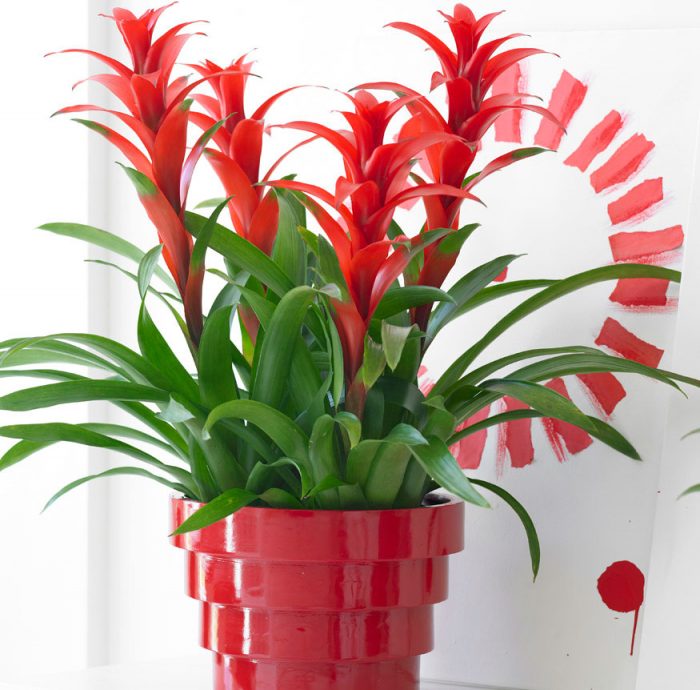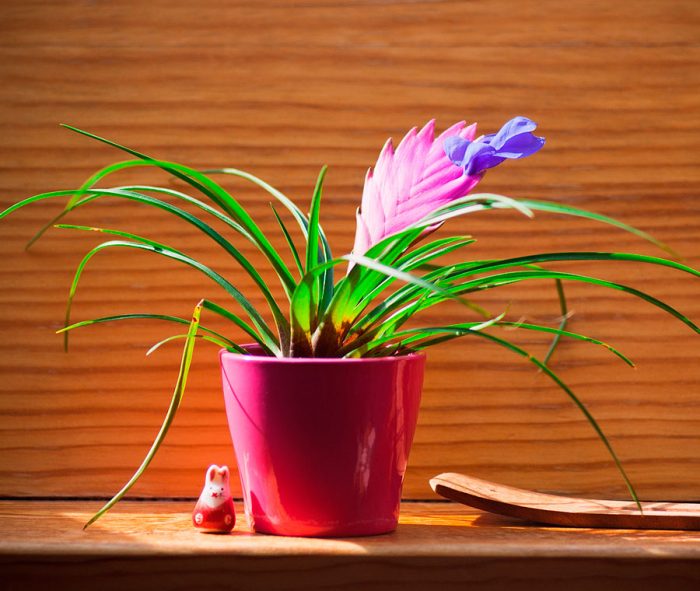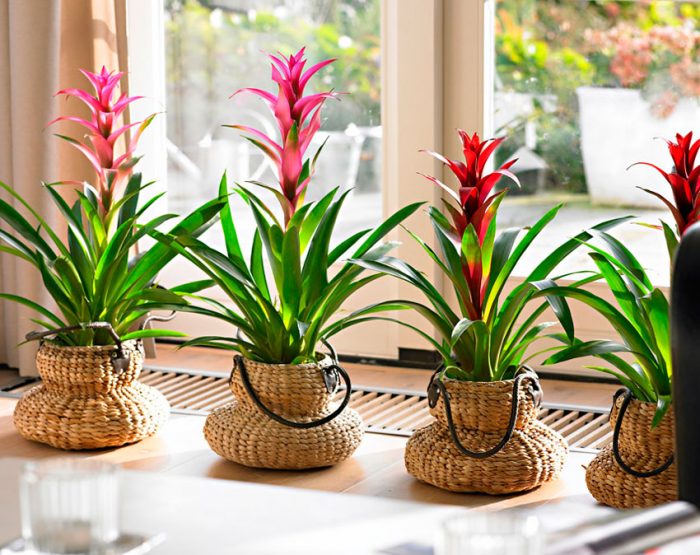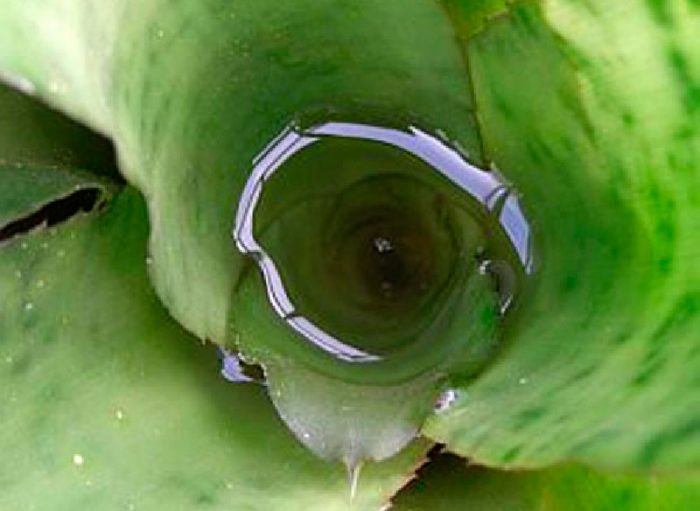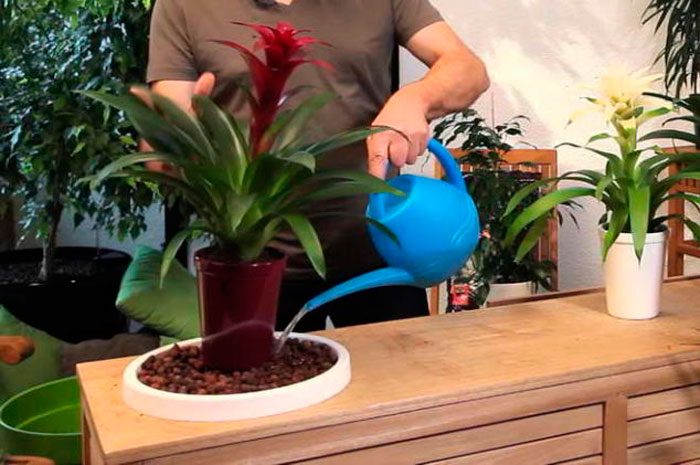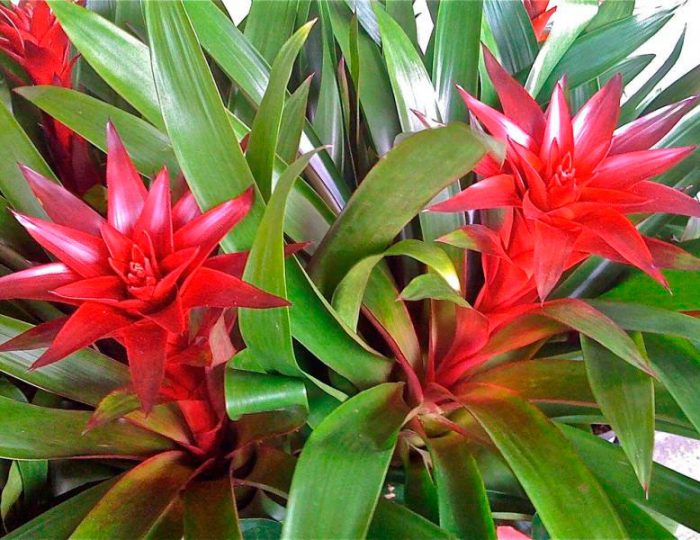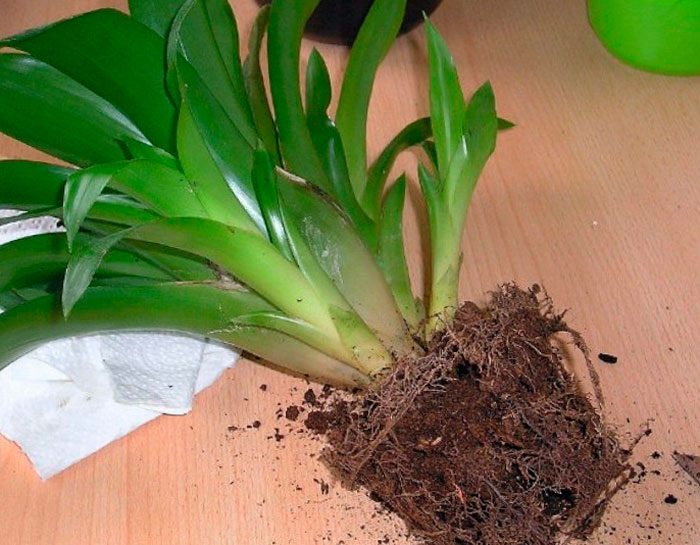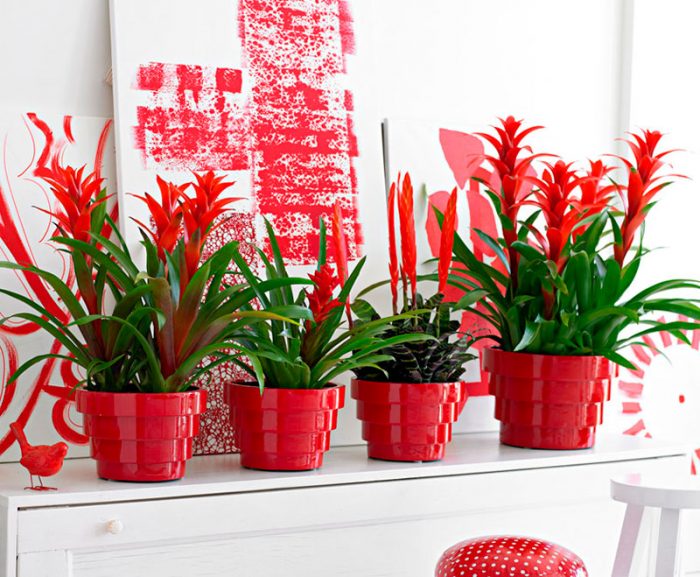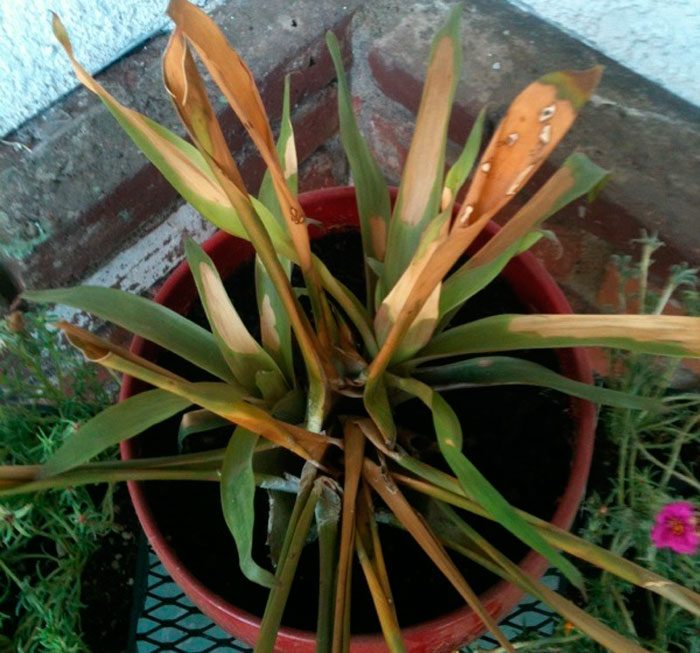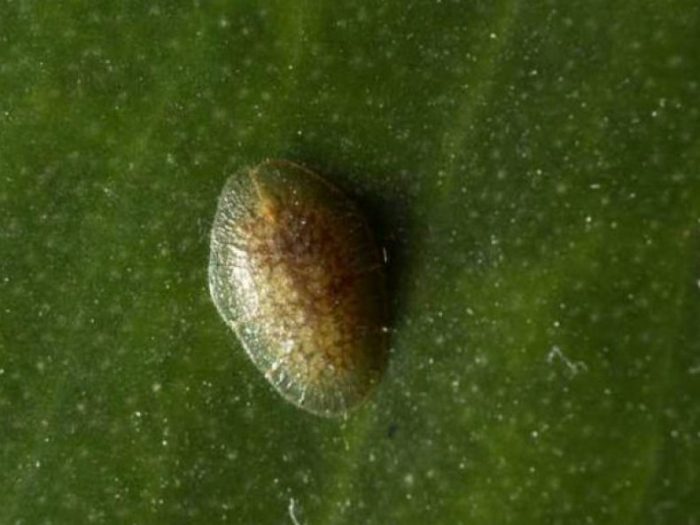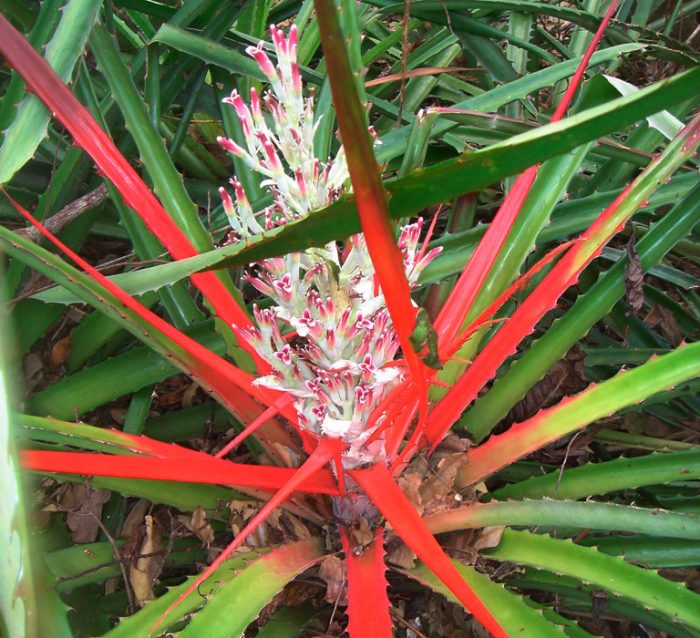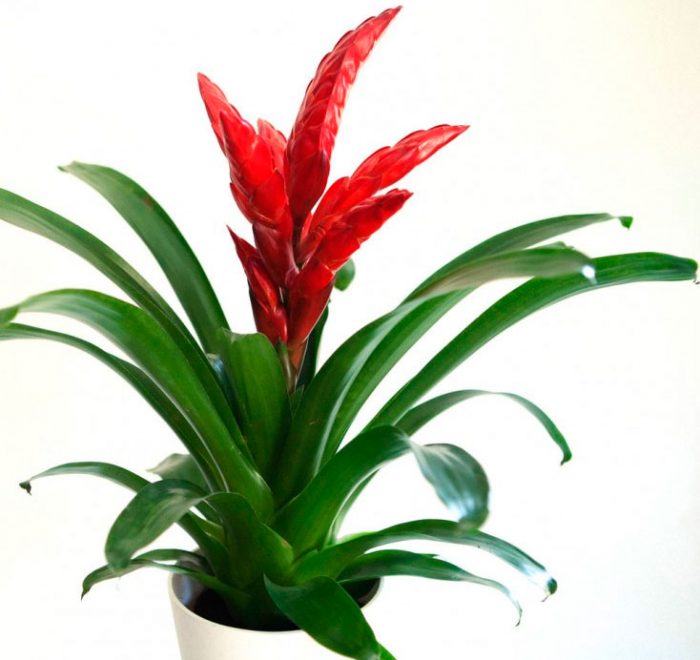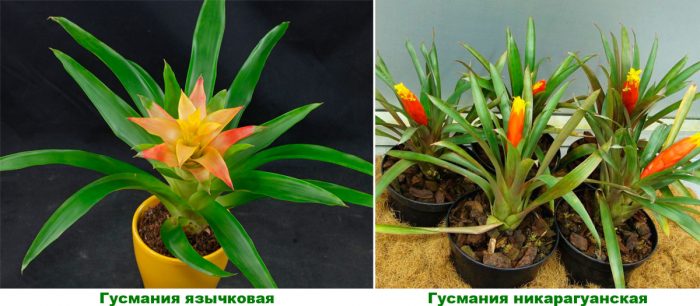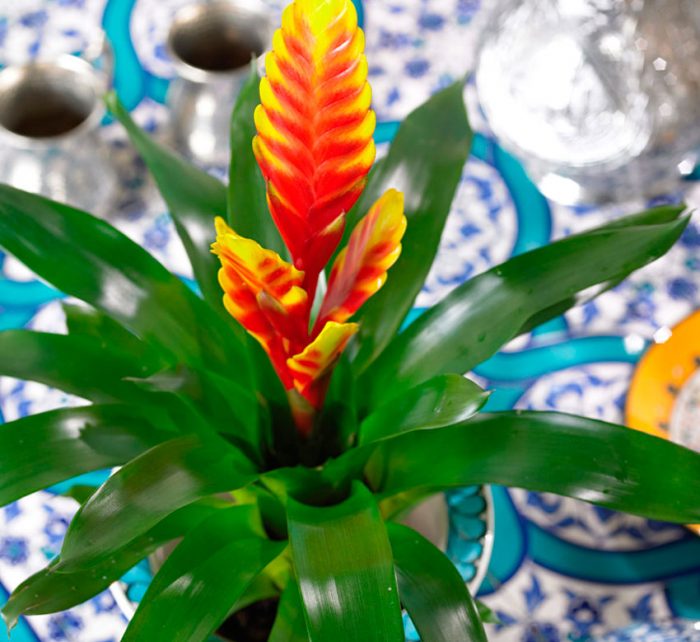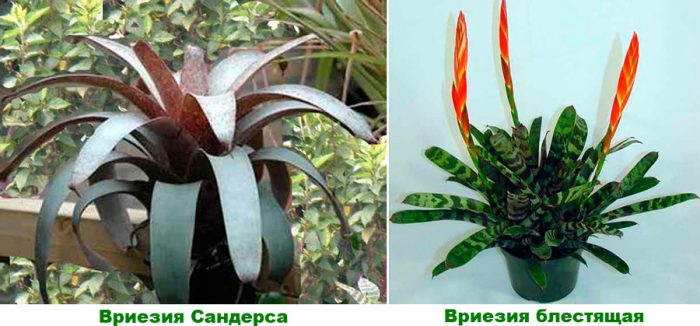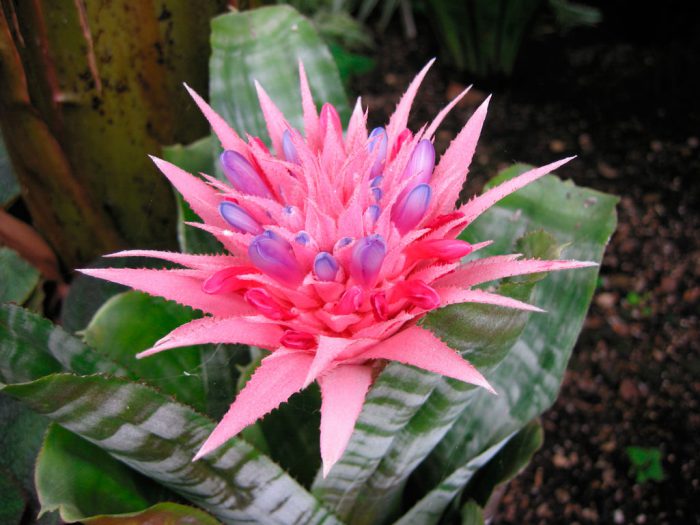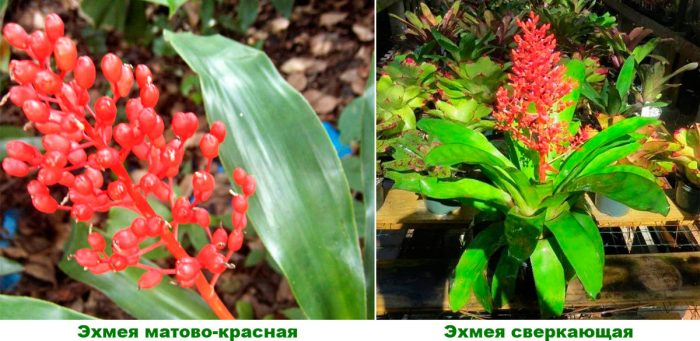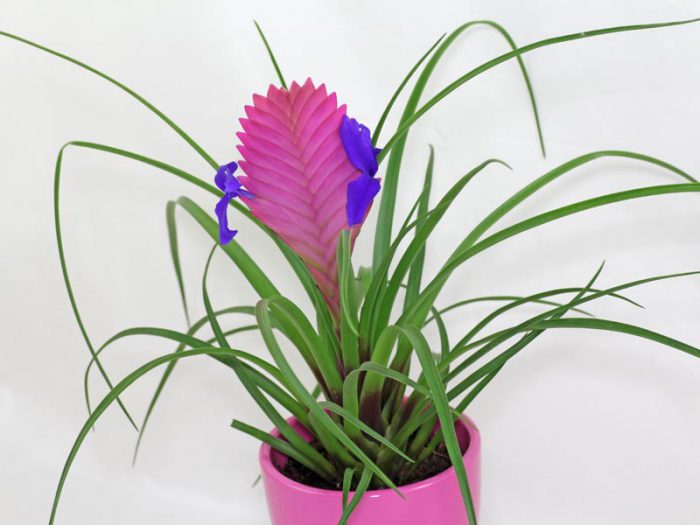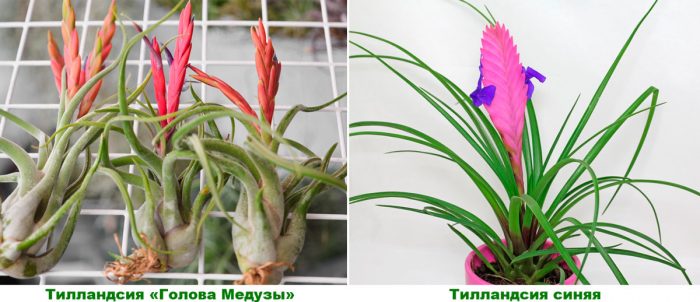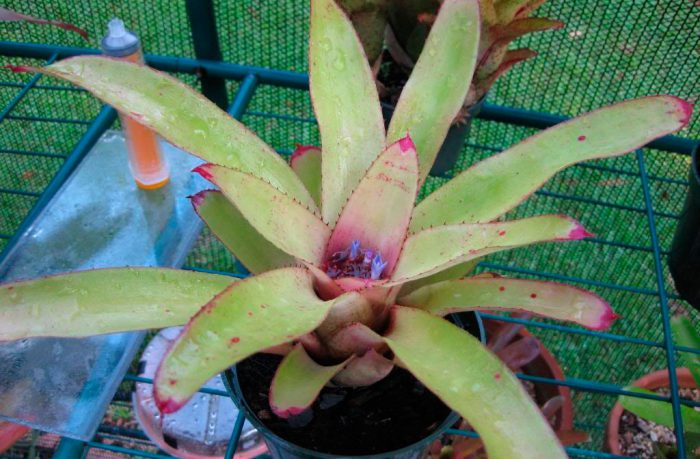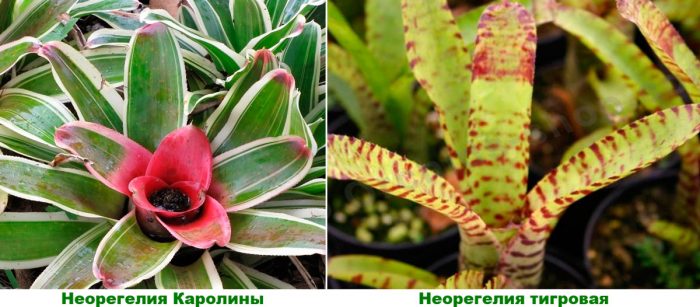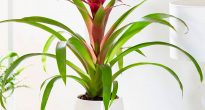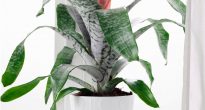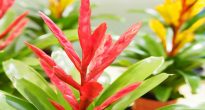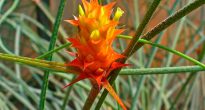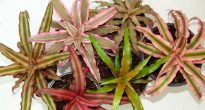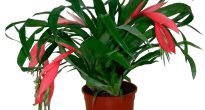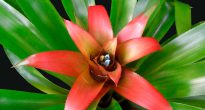The herbaceous evergreen epiphyte Bilbergia (Billbergia) is a member of the Bromeliad family. In nature, such a plant is very widespread in Brazil, but it can also be found in Argentina, Mexico, Bolivia and other countries of Central and South America. The name of the genus was given by K. Thunberg in 1821, and he named it in honor of Gustav Bilberg, who was a Swedish zoologist, lawyer and botanist. This genus unites more than 60 species, some of which are very popular with flower growers, since such a plant is characterized by undemanding care and unpretentiousness.
Content
Features of bromeliads
Indoor bromeliad is a perennial herb. The root system of the bushes is very well developed, while it reliably holds the plant in the substrate. Most often, the stem is shortened. Very beautiful leathery variegated often spiny leaf plates of a pale green color form a funnel. At the top of a long peduncle, a bright red or rich yellow inflorescence grows, which has a racemose, capitate, spike or paniculate shape. The inflorescence looks very impressive thanks to the large bracts. When the bush fades, bolls or juicy berries are formed on it, which in some species grow together into a seed. To date, about 35 species of bromeliads are cultivated by flower growers.
Caring for bromeliads at home
Illumination
Bromeliads, which are grown on the windowsill, must be kept in special conditions. Such a plant reacts extremely negatively to stagnant air, and it also needs a lot of sunlight, but it must be diffused. The room in which the flower grows is systematically ventilated and done quite often, but at the same time the bush must be protected from drafts, and it is also not placed near an air conditioner or fan. If the direct rays of the sun fall on him, then he should provide protection from them at noon. The fact is that the scorching rays of the sun can cause burns on the surface of the foliage.If possible, place the flower on an east-facing window. In winter, after the duration of daylight hours has significantly decreased, the bush needs to organize artificial additional lighting, while it is necessary to direct the light source to the ceiling, and not to the flower itself.
Temperature regime
In summer, such a plant feels best at temperatures from 20 to 25 degrees, and in winter - from 15 to 18 degrees. Do not let the temperature in the room drop below 12 degrees, but also make sure that the bromeliad is not kept at a critically low temperature for a long time.
How to water
When grown indoors, such a flower must be watered very often, and in a hot and dry period, you will have to do this every day. Experts advise pouring water during watering into the funnel formed by the leaf plates of the flower, since it is the foliage that absorbs most of the nutrients. But watering a flower with this method is quite difficult, so first you have to learn. If you have no experience in this matter, then simply pour water into the potting soil. Watering is necessary when the top layer of the soil mixture in the container dries up a little, while avoiding constant stagnation of the liquid in the substrate. However, there must be water in the pan at all times. In winter, the frequency of watering is reduced to 1 time in 7 days.
Air humidity
Such a plant needs high air humidity, while it should not fall below 70 percent. Therefore, the foliage should be systematically and quite often moistened with a spray bottle, and an open vessel with water or an aquarium is placed near the bush. You can also use an electric household air humidifier for this, or put pebbles into the pan and pour some water, and then put a pot on it. For watering and to moisten the foliage, you need to take boiled water, which should be defended for two days so that all the chlorine can come out of it. Since foliage absorbs oxygen with the help of foliage, it is imperative to monitor its cleanliness, for this, at least 1 time in 7 days, gently wipe each sheet plate with a damp soft cloth or sponge.
Fertilizer
For feeding such a culture, a solution of mineral fertilizers for flowering indoor plants is used. In the spring and summer, the bushes are fed regularly once every 15–20 days, in winter the frequency of such procedures is reduced to 1 time in 6 weeks. The nutrient solution is poured directly into the substrate, or the foliar feeding method can be used when the leaves of the plant are moistened with this mixture.
Bloom
As a rule, the bush blooms in the summer. In order to bring the moment of the beginning of flowering closer, you can resort to one trick, for this you need to put several apples near the flower pot, then they and the plant are covered with a plastic bag, which is removed only after 1.5 weeks. These fruits release ethylene, which stimulates the bush to bloom.
In bromeliads, flowers do not represent any decorative value, but its bracts are very spectacular and beautiful. The duration of flowering directly depends on the species and can last for several weeks or several months. When the bush fades, you can carefully cut off the arrow only after it is completely dry. The fact is that the faded rosette will no longer be able to bloom again, and it will die in any case, however, after it there will be children who, with proper care, can become normal adult plants after a while.
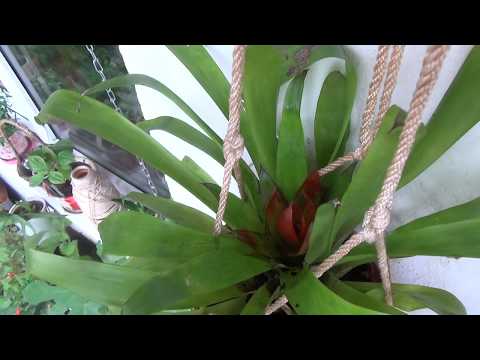

Watch this video on YouTube
Bromeliad transplant
The transplant of such a flower is carried out only as necessary after the root system becomes very cramped in the pot, and it will bulge out or hang out of the holes intended for drainage.On average, the bush is transplanted once every 2 or 3 years, and it is recommended to carry out this procedure at the very beginning of intensive growth. For growing bromeliads, use a container made of wood or ceramics. During the transplant, a new pot is taken, which in diameter will be 20-30 mm larger than the old one.
Before proceeding with the transplant, at the bottom of the new pot, you need to make a good drainage layer, after which a light moist soil mixture is poured into it that allows water and air to pass through, while it must necessarily include peat and coarse sand, in the middle you need to make a hole and fill her water. Remove the shrub from the old container and carefully free its root system from the old soil mixture. After that, the roots are placed in a previously prepared hole, which is then covered with soil mixture. Remember to compact the substrate well around the bush.
Breeding bromeliads
You can propagate such a flower at the end of flowering from February to April. At the base of the bush, after flowering ends, kiki (shoots) begin to grow. Wait 8-12 weeks, during this time they should grow and gain strength, after which they can be separated with a very sharp pre-sterilized knife, while the cuts are treated with crushed coal. Leave them outdoors for a while to dry. Since the separated processes have their own well-developed roots, they can be immediately planted in containers filled with a moist substrate consisting of sand and peat. For rooting, the shoots will need a temperature of about 20 degrees. The first flowering of these bushes can be seen after one and a half to two years.
Pests and diseases of bromeliads
Diseases of bromeliads and their treatment
Very rarely, bromeliads are affected by fungal diseases such as rust and powdery mildew. In order to cure the diseased plant, it and the soil mixture in the pot are sprayed several times with a fungicide solution containing copper. Protect the flower from direct scorching rays of the sun, as they can cause burns on the surface of the foliage that look like brown spots, therefore it must be shaded at noon, for this the window can be covered with a light curtain.
If liquid constantly stagnates in the root system of the plant, then the foliage of bromeliads loses turgor and begins to turn yellow, especially if the room is also cool. If the watering is excessively poor, and the humidity in the room is very low, then the tips of the leaf plates turn brown. From this it becomes clear that the bush is getting sick due to improper care or inappropriate growing conditions.
Bromeliad pests and control
Also, due to non-compliance with the rules of care, various harmful insects can settle on a weakened bush. Most often, scale insects or mealybugs settle on it. Pests should be removed from the flower by hand, after which the leaf plates on both sides are wiped with a cotton swab, which is pre-moistened in a soap solution. After some time, the bush must be rinsed with clean water, while the surface of the soil mixture in the container must be covered with a film. If harmful insects still remain, the bush should be sprayed with a solution of an insecticidal drug (Aktara, Fitoverm or Aktellik). However, during processing, do not allow the chemical to enter the funnel. An excellent substitute for chemistry in pest control will be tobacco infusion.
Species and varieties of bromeliads with photos and names
Bromeliad penguin (Bromelia pinguin)
Of all the species of the genus Bromelia, only the bromeliad penguin (Bromelia pinguin) is cultivated by flower growers. This species is native to Ecuador, Costa Rica, Mexico and Venezuela. This plant contains the biologically active enzyme penguinin. In bromeliads growing in nature, large infructescences are formed, which include oblong fruits.
However, flower growers call bromeliads not only plants belonging to the genus of the same name, but also those species that belong to other genera of the Bromeliads family.
Guzmania, or guzmania
This stemless epiphytic plant can be found in natural conditions in South Florida, Ecuador, Brazil, West Indies and Colombia. This plant is very popular with flower growers. Belt-shaped leathery leaf plates form a goblet rosette; in bushes growing in nature, rainwater or morning dew accumulates in it. The inflorescence is located on the leafy arrow, and it contains flowers that do not represent any decorative value, and it also has bracts of rich orange, purple, yellow or red color. The following types and cultivars of this plant are most popular among flower growers:
- Guzmania reed... A large bush has a dense rosette, which includes leaf plates of a rich green color, having a length of about half a meter. There are brown stripes on the seamy surface of the plates. The inflorescence is formed on a short peduncle, it consists of small white flowers, however, due to the apical leaf plates of orange or red color, they are very difficult to see. The varieties are available: Tempo and Minor.
- Guzmania Nicaraguan... The bush of this species is small, it grows well at home. An upright spike-shaped inflorescence consists of lemon-yellow flowers, and the bush is also decorated with scarlet bracts. The compact dense rosette includes from 10 to 15 smooth greenish lingual leaf plates, their length is about 50 mm, and their width is up to 25 mm. On their front surface there are small scales, and the seamy one has a purple or brown color.
Even in indoor conditions, such species are cultivated as: mosaic gusmania, tricolor, blood red, Ostara, one-eared, Donnella-Smith and conifer.
Vriesea
It is a tropical South American plant. Bright large inflorescences have a spike-shaped or paniculate shape. Long juicy and dense leaf plates are collected in a spectacular rosette. Vriese is represented by epiphytes and terrestrial forms. Most often, the following species are grown at home:
- Vriezia Sanders... In diameter, the rosette reaches about 0.6 m, while its height is up to 0.4 m, it consists of smooth and leathery leaf plates of greenish-gray color, they often have a purple hue, which is most clearly visible on the seamy surface of the foliage. A straight or drooping peduncle in the upper part has an inflorescence, consisting of spike-shaped brushes, they include flowers and stipules of yellow color.
- Vriezia is brilliant or beautiful... Such a plant in nature can be found in a humid tropical forest. The rosette consists of broad-lanceolate leaf plates, the length of which is about 0.4 m, they are variegated, and their surface seems to be covered with transverse strokes of a dark color. The stripes are both purple and dark green. At the apex of the erect peduncle there is a wide spike-shaped lanceolate inflorescence, which consists of yellow flowers and carmine-red bracts.
Even in indoor conditions, keeled, royal, perforated, hieroglyphic and giant vriezia are also cultivated.
Ehmea (Aechmea)
Such an epiphytic plant is native to Central and South America. In bushes, funnel-shaped rosettes are formed by sheet plates with a serrated edge. A spectacular inflorescence is formed on a thick and long peduncle. The following types are popular among flower growers:
- Ehmeya matte red... The structure of the funnel-shaped dense rosette includes lingual sheet plates, reaching about half a meter in length, there are scales on their surface, and their edge is finely serrated. The foliage has a greenish front surface, and a lavender on the back.The inflorescence includes deep red bracts and bluish flowers.
- Ehmeya sparkling... A loose rosette consists of belt-like sheet plates with a rounded tip and a serrated edge, their width is about 6 centimeters, and their length is up to 40 centimeters. The foliage has a greenish color with a bluish bloom. At the top of the peduncle, an inflorescence is formed, which consists of deep pink bracts and flowers of a coral-red hue with a blue tip.
Even at home, you can meet holosteel, tailed (bearded), striped, shaggy, curved, two-rowed, Weilbach, etc.
Tillandsia
This genus of herbaceous plants unites about 500 species. In natural conditions, they can be found in North and South America. Most of the species of such a plant are epiphytes, but there are also lithophytes growing on stones, as well as terrestrial species. Some species are widely cultivated at home:
- Tillandsia "Head of Medusa"... This type is the most popular, it has an unusual shape. Outwardly, the bush is similar to a bulb with leafy plates closed at the base, which bend to the side only in the upper part. As a rule, the leaf rosette is inverted, the length of the flowers of a deep purple color is about 3.2 cm, the shape of the inflorescence is finger-shaped or linear.
- Tillandsia blue... The leaf plates are curved and narrow, they reach about 0.3 m in length. The brownish-red base of the leaves is covered with small scales. The dense inflorescence has an elliptical spike-like shape, it includes small purple or blue flowers, as well as bracts of pink or lilac color.
Still in room conditions, Tillandsia Duer, Linden, Sitnikovaya, silvery, Gardner's, violet-flowered, etc. are grown.
Neoregelia
It is a herbaceous perennial plant native to Colombia, Ecuador, Peru and Brazil. Shiny and smooth leaf plates have a broad-linear belt-like shape; they are prickly along the edge. In the middle of the outlet, the foliage is often lavender or whitish, while when the bush blooms, their tips or they turn completely red. A racemose inflorescence grows from the middle of the outlet. The most popular types:
- Neoregelia Carolina... In diameter, the funnel-shaped, wide-spreading rosette reaches about half a meter, it consists of shiny rich green lingual leaf plates, on the edge of which there are a large number of thorns. When the bush blooms, the upper leaf plates of the rosette turn red. In the depths of the leaf rosette, a simple capitate inflorescence is formed, consisting of bracts of a milky green color and light lilac flowers, reaching 40 mm in length. There are varieties in which longitudinal stripes of green, pink or white are located on the foliage surface.
- Tiger neoregelia... The dense rosette of a round shape includes tongue-shaped leaf plates with a pointed top, along the edge they have brown thorns. The foliage looks very impressive due to the irregular brown stripes that are located on its surface, at the base of the plate are covered with small scales. The composition of the multi-flowered simple inflorescence includes light purple flowers and spatulate asymmetric bracts of a pale red hue at the apex.
Other types are cultivated in indoor conditions: blue neoregelia, vesicular, scion, few-flowered, beautiful (elegant), gloomy, marble, etc.


Watch this video on YouTube

